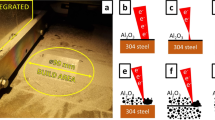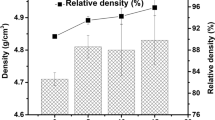The effect of preliminary mechanical activation on the structural and physical state of the starting reagents, phase formation, and structure of sintered 80 vol.% ZrB2–15 vol.% SiC–5 vol.% B4C ceramics was studied. The starting powders were mechanically activated in steel drums of an AIR water-cooled high-energy ball mill at a rotation speed of 1440 rpm in an argon atmosphere. The mechanical activation lasted 15, 30, 60, and 120 min. The samples were produced by hot pressing using an SPD-120 pilot plant with induction heating in graphite dies in a CO–CO2 atmosphere. The particle-size distribution was determined by laser diffraction. Metallographic studies were conducted using a Superprobe 733 electron microscope (Japan). The mechanical activation of ultrahigh-temperature ceramics was found to influence the compaction kinetics of the samples. When mechanical activation time increased from 15 to 120 min, the sample density increased by 10% in the hot pressing process at 2150°C (15 min). The samples had 5–10 μm particles. During hot pressing, the ZrB2 matrix phase acquired a skeletal structure: the SiC phase in an amount of 15 vol.% acted as reinforcement in partial dissociation and B4C in an amount of 5 vol.% acted as a boron and carbon donor. Preliminary mechanical activation of the 80 vol.% ZrB2–15 vol.% SiC–5 vol.% B4C powder mixture intensified sintering in the temperature range 2100–2150°C, featuring the formation of secondary phases and recrystallization (at 2150°C), and promoted high density and low porosity of the hot-pressed ceramics. The studies showed that the densest samples were sintered from the powder mixture mechanically activated for 120 min. The density of the samples hot-pressed at 2100°C (5 min) and 2150°C (15 min) increased.













Similar content being viewed by others
References
O.N. Grigoriev, G.A. Frolov, Yu.I. Evdokimenko, V.M. Kisel, A.D. Panasyuk, and A.V. Koroteev, “Ultrahigh-temperature ceramics for aviation and space vehicles,” Aviats. Kosm. Tekhn. Tekhnol., 95, No. 8, 119–128 (2012).
L. Rangaray, S.J. Surecha, C. Divakar, and V. Jayaram, “Low-temperature processing of ZrB2–ZrC composites by reactive hot pressing,” Metall. Mater. Trans. A, 39, No. 7, 1496–1505 (2008).
M.J. Gasch, D.T. Ellerby, and S.M. Johnson, “Ultra high temperature ceramic composites,” in: N.P. Bansal (ed.), Handbook of Ceramic Composites, Kluver Academic Publishers, New York (2005), pp. 197–224.
J. Gozalez-Julian, O. Cedillos-Barraza, and S. Döring, “Enhanced oxidation resistance of ZrB2/SiC composite through in situ reaction of gadolinium oxide in patterned surface cavities,” J. Eur. Ceram. Soc., 34, No. 16, 4157–4166 (2014).
M.S. Kovalchenko and L.F. Ochkas, “Creep in hot pressing of the zirconium carbide powder,” in: Proc. All-Union Conf. Metal Ceramic Materials and Parts [in Russian], Izd. Erevan. Politekh. Inst., Erevan (1973), pp. 139–143.
S.V. Matrenin, “Sintering of oxide ceramics activated by additions of nanosized powders,” Izv. Tomsk. Politekh. Univ. Khim., 317, No. 3, 24–28 (2010).
Inorganic Materials [in Russian], Naukova Dumka, Kyiv (2008), Vol. 2, Book 1, p. 854.
V.I. Iveronova and G.P. Revkevich, Theory of X-Ray Scattering [in Russian], Izd. Mosk. Univ., Moscow (1978), p. 276.
G.S. Oleinik, Structurization of Ceramic Materials [in Russian], Naukova Dumka, Kyiv (2018), p. 303.
V.B. Vinokurov, M.S. Kovalchenko, L.I. Klimenko, N.D. Bega, and T.V. Mosina, “Kinetics of nonisothermal pressure sintering of zirconium diboride powder with additives of boron and chromium carbides in vacuum,” Powder Metall. Met. Ceram., 57, No. 1–2, 27–37 (2018).
V.I. Kovtun, O.N. Grigoriev, N.D. Bega, V.M. Volkogon, and M.V. Karpets, “Structure of the WC powders processed by shock waves,” in: Rock-Cutting and Metal-Working Tools—Production and Application Equipment and Processes (Collected Scientific Papers) [in Russian], Inst. Nadtverd. Mater. Bakulya NAN Ukrainy, Kyiv (2008), No. 11, pp 381–387.
O.N. Grigoriev, L.A. Kryachko, N.D. Bega, A.V. Laptev, M.E. Golovkova, N.N. Rozhenko, and E.I. Bersudskii, “Effect of ball grinding on structural characteristics of tungsten powder,” Elektron. Mikrosk. Prochn. Mater. Ser. Fiz. Materialoved. Strukt. Svoist. Mater., Issue 19, 114–122 (2013).
M.D. Bega, V.B. Vinokurov, B.O. Galanov, O.N. Grigoriev, V.V. Kartuzov, P.V. Mazur, N.M. Rozhenko, and A. V. Stepanenko, “X-ray diffraction of tungsten carbide powder substructure after grinding,” Elektron. Mikrosk. Prochn. Mater. Ser. Fiz. Materialoved. Strukt. Svoist. Mater., Issue 22, 58–72 (2016).
Author information
Authors and Affiliations
Author notes
T. O. Liudvinskaya is deceased
- T.O. Liudvinskaya
Translated from Poroshkova Metallurgiya, Vol. 60, Nos. 1–2 (537), pp. 87–98, 2021.
Corresponding author
Additional information
Translated from Poroshkova Metallurgiya, Vol. 60, Nos. 1–2 (537), pp. 87–98, 2021.
Rights and permissions
About this article
Cite this article
Liudvinskaya, T., Mosina, T., Neshpor, I. et al. The Effect of Mechanical Activation on the Compaction and Structurization of Hot-Pressed ZrB2 Ceramics. Powder Metall Met Ceram 60, 69–77 (2021). https://doi.org/10.1007/s11106-021-00216-2
Received:
Published:
Issue Date:
DOI: https://doi.org/10.1007/s11106-021-00216-2




